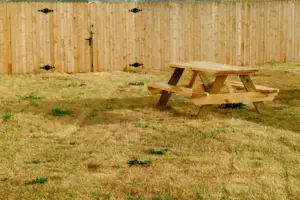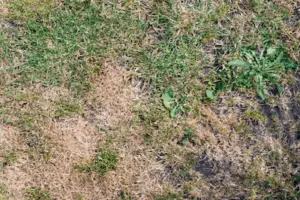Fixing Yellow Grass Caused By Fertilizing
Until you are responsible for maintaining your own lawn, you likely do not realize everything that goes into proper lawn care. Achieving a lush, green yard requires much more than cutting the grass every few weeks. One of the additionals steps you must take to maintain your lawn is regular fertilization. However, this can present some additional complications that prevent the beautiful yard of your dreams.
So, why is your grass yellow after fertilizing? While fertilizer can provide great benefits to your grass, it can cause serious problems if not done properly. If you notice that your grass has turned yellow after fertilization, it is likely that you either used too much fertilizer or not enough fertilizer. Most homeowners tend to use too much fertilizer which leads to a condition called fertilizer burn.
It can be quite frustrating to set aside time for proper lawn care and maintenance only to end up damaging your lawn in the end. In this article, we will share some tips for treating yellow spots in your lawn as well as preventing this problem from reoccurring in the future.
How to Fix Yellow Grass After Fertilizing
So you spent a few hours fertilizing your grass over the weekend, and you now notice yellow spots. How did this happen? Weren’t you doing the grass a favor, after all? Although yellow spots in your grass can be caused by a variety of things, improper use of fertilizer is the most common.
What is Fertilizer Burn?
Fertilizer is composed of many ingredients that are designed to encourage healthy growth. Things such as chemicals, salt, and nitrogen are all beneficial to your lawn when you use them in the proper way. However, when you apply too much fertilizer or use it too often, they can actually damage your lawn.
Fertilizer burn appears as yellow or brown patches of grass, usually with a dead appearance. You will often notice the first signs of fertilizer burn between one to three days following the use of fertilizer in your yard.
There are a few reasons this damage occurs. The salt and chemicals that are found in fertilizer will dehydrate your grass if they begin to build up. This can happen when you use fertilizer too often.
Nitrogen is one of the most active ingredients in most fertilizers as it encourages your grass to appear lush and green. Too much nitrogen, however, will alter the ph level of your soil, burning the roots of your grass. Using too much fertilizer at once, or dumping a large amount in one location, will cause fertilizer burn in this way.
If you notice that your grass is yellow yet you haven’t recently used fertilizer, it is likely that there is another cause of the yellow grass such as pet urine. Not using enough fertilizer can also create yellow spots as the grass is void of essential nutrients.
How Long Does Fertilizer Burn Last?
Most often, fertilizer burn becomes apparent between one day and one week of fertilizer use. While fertilizer burn may prove deadly to your lawn, you may be able to reverse the negative impact if you react quickly. With the right intervention, you may be able to reverse the signs of fertilizer burn within a few weeks.
Easy Solutions for Fixing Yellow Grass Caused By Fertilizer
Luckily, there are several easy solutions for fixing the yellow spots in your lawn caused by fertilizer burn. By reacting quickly to the appearance of damage, you may be able to avoid replacing your grass, a long and tedious process.
Determine the Cause of Damage
First, you must determine the cause of the damage to your lawn. If you haven’t used fertilizer recently, it’s likely that the damage was caused by something else such as the family pet. In many cases, however, yellow spots in the grass are the result of improper fertilizer use.
Determining whether you used too much fertilizer or too little will provide you with important information regarding your next steps.
Adjust Fertilizer Use According to Damage
Because the improper use of fertilizer can have such negative effects on your green grass, it’s important to carefully read the directions provided by the manufacturer. The fertilizer you choose to purchase will have specific directions on the packaging that outline the amount of fertilizer you should use for the square footage of your yard.
Be sure to accurately measure your space, making note of any areas of your yard which do not require fertilization. Proper calculations can prevent serious lawn damage.
It is also important to be sure you are applying fertilizer at proper intervals. Most companies recommend using fertilizer once during the spring and once during the fall. Specifics will vary depending on your geographical location, however, so it is important that you do your research.
Safely Remove Excess Fertilizer to Prevent a Yellow Lawn
If you determine that you used too much fertilizer, it is wise to consider removing the excess if possible. This is especially important in the event that you spilled the fertilizer in one location. It is never wise to handle fertilizer with your bare hands. For this reason, it is recommended that you use an outdoor broom, shop vacuum, or other yard tools to safely remove and dispose of the extra fertilizer.
Flush Soil With Plenty of Water Without Overwatering
Depending on your yard and the length of your grass, it may not be possible to remove the excess fertilizer. One of the best ways to prevent further damage to your grass is to flush the soil with plenty of clean water. It is important to note that fertilizer can cause damage to other areas of your yard.
When you are attempting to flush the soil, thoroughly soak the ground then allow the water to absorb fully before repeating the process. Most experts recommend repeating this process once a day for several weeks.
Replant Grass if Needed in Areas of Extreme Damage
In some situations, your grass may be beyond the point of repair. When extreme damage has been caused by improper fertilization, you may need to consider replanting the grass in the affected areas.
Avoiding a Yellow Lawn Caused By Fertilizer Burn
If you have ever experienced fertilizer burn, you are likely hoping to avoid a recurrence at all costs. Here are a few ways to avoid further damage to your lush green lawn.
Follow Manufacturer Directions
As mentioned previously, it’s important to follow manufacturer directions when applying fertilizer. Even if you have fertilized your yard before, take a few minutes to thoroughly read the directions as there may be vital differences. This can save you great frustration and wasted time due to correcting fertilizer burn.
Fix Other Lawn Issues Before Fertilizing
Fertilizer is designed to improve the overall health of your lawn. However, it is not wise to apply fertilizer to a yard that is not in optimal condition. If your lawn does not have proper drainage or circulation, it will not respond properly to fertilization, causing greater problems than you originally had.
Use a Fertilizer Appropriate for Your Grass
Before you use fertilizer to improve the condition of your lawn it is important to realize that not every fertilizer is appropriate for your grass. With many varieties of grass and many differences in geographical locations, it is important to do your research to find a fertilizer that will improve the health of your grass.
If you are confused as to what type of fertilizer to purchase, it may be helpful to consult a lawn care specialist or an employee at your local hardware store.
Never Spread Fertilizer By Hand to Prevent a Yellow Lawn
You may be hesitant to purchase another yard tool specifically for spreading fertilizer. However, it is really the only way to ensure that you do not over or under fertilize your lawn. Not only can fertilizer be harmful to your skin if spread with your bare hand but doing so is highly unreliable.
Investing in a spreader will ensure that the fertilizer is evenly distributed. Preventing the possibility of fertilizer burn or other lawn damage.
Water the Lawn After Fertilizing
Unless specifically noted on the packing of the fertilizer you are using, it is important to water your lawn immediately after applying the fertilizer. Doing so will help the fertilizer to reach the roots of the grass. Once it reaches the roots, it can begin to do its work.
Thoroughly watering your grass following fertilization will also rinse the salt and chemical off the green blades. This minimizes the potential for a dull or damaged lawn.
Final Thoughts
Lawn care can quickly become overwhelming. However, there is no substitute for a soft, luscious yard. By taking the time to educate yourself on proper lawn care and maintenance, you will provide you and your family with a beautiful area in which to relax and spend time together.
Proper fertilization is one of the most valuable steps to promoting healthy lawn growth. The proper use of a fertilizer that is appropriate for your variety of grass will reap generous benefits. And if you found this article as a result of improper fertilizer use, take heart! By following the easy steps outlined above, you can return your grass to a healthy state once again.



